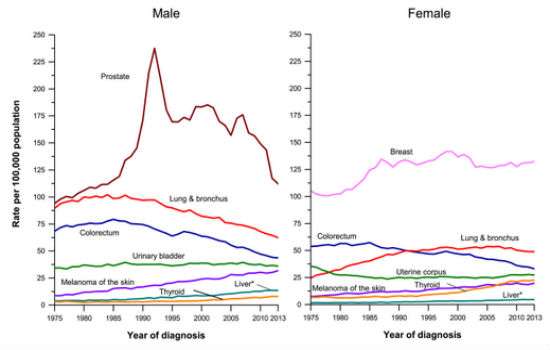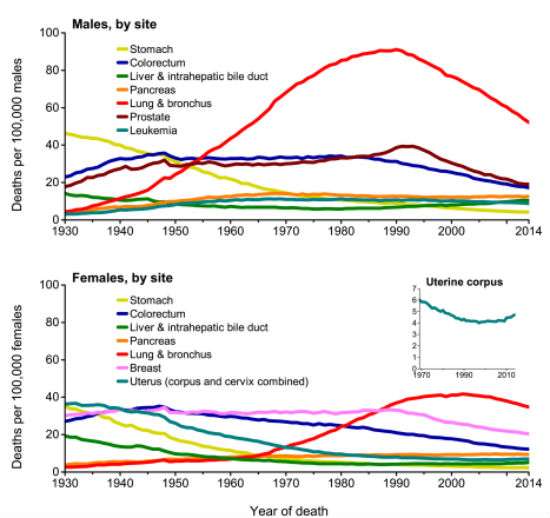Correction: Cancer Death Rates Fall Further: Incidence Declines for Men and Remains Steady for Women
Better News: Cancer death rates dropped 25 percent from its 1991 peak of 215.1 (per 100,000 population)to 161.2 in 2014.

Yesterday, I erroneously reported falling death and cancer incidence rates from Cancer Statistics 2016, not the new report Cancer Statistics 2017. Obviously, I am embarrassed by this mistake, but I am happy to report that the good news is that the positive trends continue.
The overall cancer death rate dropped 25 percent from 1991, translating to approximately 2,143,200 fewer cancer deaths than would have been expected if death rates had remained at their peak, according to the latest Cancer Statistics 2017 report from the American Cancer Society. Over the past decade of available data, the overall cancer incidence rate (2004-2013) was stable in women and declined by approximately 2% annually in men, while the cancer death rate (2005-2014) declined by about 1.5% annually in both men and women.
The falling incidence trend for men reflects large continuing declines for cancers of the lung and colorectum, in addition to a sharp reduction in prostate cancer incidence of more than 10% annually from 2010 to 2013. The drop in lung and colorectal cancer is largely due to less smoking and more colonoscopies. The reduction in prostate cancer diagnosis is largely the result new guidelines from the U.S. Preventive Services Task Force against routine screening with the PSA test because of growing concerns about high rates of overdiagnosis. It is worth noting that that contrary to the USPST's blanket recommendation, the American Cancer Society urges men to talk with their physicians about the risks and benefits and decide for themselves whether they want the screening test.

The report further notes:
The lifetime probability of being diagnosed with invasive cancer is slightly higher for men (40.8%) than for women (37.5%). Reasons for the increased susceptibility in men are not well understood, but to some extent reflect differences in environmental exposures, endogenous hormones, and probably complex interactions between these influences. Adult height, which is determined by genetics and childhood nutrition, is positively associated with cancer incidence and death in both men and women, and has been estimated to account for one-third of the gender disparity in cancer risk.
The fact that lifetime probability of cancer for both men and women has fallen slightly from those estimates in the 2016 report is more good news. Being male and standing at 6 feet 5 inches, I'm at higher risk, but the mortality trends give me some scope for optimism. After all, at a conference in 2015, Dr. D. Gary Gilliland, president and director of Fred Hutchinson Cancer Research Center, declared, "It's actually plausible that in 10 years we'll have curative therapies for most if not all human cancers."
With regard to mortality trends, the ACS reports:
The decline in cancer mortality over the past 2 decades is the result of steady reductions in smoking and advances in early detection and treatment, reflected in considerable decreases for the 4 major cancers (lung, breast, prostate, and colorectum). Specifically, the death rate dropped 38% from 1989 to 2014 for female breast cancer, 51% from 1993 to 2014 for prostate cancer, and 51% from 1976 to 2014 for colorectal cancer. Lung cancer death rates declined 43% from 1990 to 2014 among males and 17% from 2002 to 2014 among females due to reduced tobacco use ….

It is still the case that there is no rising cancer epidemic; much less one that can be attributed to modern technologies like cell phones, genetically modified crops and trace exposures to synthetic chemicals.
Again, I regret the error and I hope that readers were not unduly confused by it.


Show Comments (33)